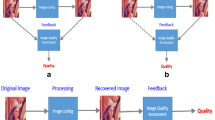Abstract
Blind image quality assessment (BIQA) can assess the perceptual quality of a distorted image without a prior knowledge of its reference image or distortion type. In this paper, a novel BIQA model is developed in wavelet domain. Considering the multi-resolution and band-passing characteristics of discrete wavelet transform (DWT), an improvement over the power spectrum is put forward, i.e., dubbed wavelet power spectrum (WPS) estimation. Then, the concept of directional WPS is applied to simplify the calculation. Moreover, a rotationally symmetric modulation transfer function (MTF) of human visual system (HVS) is integrated as a filter, which makes the metric to be consistent with the human vision perception and more discriminative. Experiments are conducted on the LIVE databases and three other databases, and the results show that the proposed metric is highly correlated with subjective evaluations and it competes well with other state-of-the-art metrics in terms of effectiveness and robustness.
Similar content being viewed by others
References
Ferzli R, Karam L J. A no-reference objective image sharpness metric based on the notion of just noticeable blur (JNB)[J]. IEEE Transactions on Image Processing, 2009, 18(4): 717–728.
Bahrami K, Kot A C. A fast approach for no-reference image sharpness assessment based on maximum local variation[J]. IEEE Signal Processing Letters, 2014, 21(6): 751–755.
Mittal A, Moorthy A K, Bovik A C. No-reference image quality assessment in the spatial domain[J]. IEEE Transactions on Image Processing, 2012, 21(12): 4695–4708.
Mittal A, Soundararajan R, Bovik A C. Making a “Completely Blind” image quality analyzer[J]. IEEE Signal Processing Letters, 2013, 20(3): 209–212.
Moorthy A K, Bovik A C. Blind image quality assessment: From natural scene statistics to perceptual quality[J]. IEEE Transactions on Image Processing, 2011, 20 (12): 3350–3364.
Saad M A, Bovik A C, Charrier C. Blind image quality assessment: A natural scene statistics approach in the DCT domain[J]. IEEE Transactions on Image Processing, 2012, 21(8): 3339–3352.
Lu W, Zeng K, Tao D C et al. No-reference image quality assessment in contourlet domain[J]. Neurocomputing, 2010, 73(4-6): 784–794.
Li Y M, Po L M, Xu X Y et al. No-reference image quality assessment using statistical characterization in the shearlet domain [J]. Signal Processing: Image Communication, 2014, 29(7): 748–759.
Liu L X, Dong H P, Huang H et al. No-reference image quality assessment in curvelet domain [J]. Signal Processing: Image Communication, 2014, 29(4): 494–505.
Vu P V, Chandler D M. A fast wavelet-based algorithm for global and local image sharpness estimation[J]. IEEE Signal Processing Letters, 2012, 19(7): 423–426.
Zhao H J, Fang B, Tang Y Y. A no-reference image sharpness estimation based on expectation of wavelet transform coefficients[C]. In: International Conference on Image Processing. Melbourne, Australia, 2013.
Chen Q W, Xu Y, Li C et al. An image quality assessment metric based on quaternion wavelet transform[C]. In: International Conference on Multimedia and Expo Workshops. San Jose, USA, 2013.
Reenu M, David D, Raj S S A et al. Wavelet based sharp features(WASH): An image quality assessment metric based on HVS[C]. In: 2nd International Conference on Advanced Computing, Networking and Security. Mangalore, India, 2013.
Zhang Y, Jin W Q. A new objective evaluation index to fusion images quality based on power spectrum and HVS characteristics[C]. In: Symposium on Photonics and Optoelectronic. Chengdu, China, 2010.
Qu Y G, Zeng S G, Xia D S. Appraise the CBERS-1 image quality with image information capacity and power spectrum[J]. Spacecraft Recovery & Remote Sensing, 2002, 23(2): 40–45(in Chinese).
Zhang Y, An P, Zhang Q W et al. A no-reference image quality evaluation based on power spectrum[C]. In: 3DTV Conference: The True Vision-Capture, Transmission and Display of 3D Video(3DTV-CON). Antalya, Turkey, 2011.
Torrence C, Compo G P. A practical guide to wavelet analysis[J]. Bulletin of the American Meteorological Society, 1998, 79(1): 61–78.
Mannos J, Sakrison D J. The effects of a visual fidelity criterion on the encoding of images[J]. IEEE Transactions on Information Theory, 1974, IT-20(4): 525–536.
Depalma J J, Lowry E M. Sine-wave response of the visual system, II. Sine-wave and square-wave contrast sensitivity [J]. Journal of the Optical Society of America, 1962, 52(3): 328–335.
Nill N. A visual model weighted cosine transform for image compression and quality assessment [J]. IEEE Transactions on Communications, 1985, 33(6): 551–557.
Cui H, Song G X. Study of the wavelet basis selections[C]. In: 2006 International Conference on Computational Intelligence and Security. Guangzhou, China, 2006.
Sheikh H R, Wang Z, Cormack L et al. LIVE Image Quality Assessment Database [EB/OL]. http://live.ese.utexas.edu/research/quality, 2003.
Antkowiak J, Baina T J. Final Report from the Video Quality Experts Group on the Validation of Objective Models of Video Quality Assessment [R]. ITU-T Standards Contribution COM, 2000.
Sheikh H R, Bovik A C. Image information and visual quality[J]. IEEE Transactions on Image Processing, 2006, 15(2): 430–444.
Author information
Authors and Affiliations
Corresponding author
Additional information
Lu Pengluo, born in 1988, female, doctorate student.
Rights and permissions
About this article
Cite this article
Lu, P., Li, Y., Jin, L. et al. Blind image quality assessment based on wavelet power spectrum in perceptual domain. Trans. Tianjin Univ. 22, 596–602 (2016). https://doi.org/10.1007/s12209-016-2726-7
Accepted:
Published:
Issue Date:
DOI: https://doi.org/10.1007/s12209-016-2726-7




